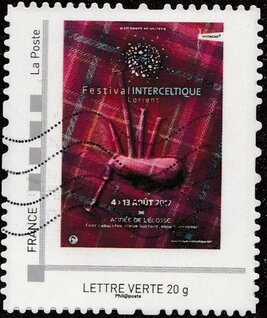Stamp: Interceltic Festival Lorient 2017 Poster (France 2017)
Interceltic Festival Lorient 2017 Poster (France 2017)
01 January (France ) within release Collector : Interceltic Festival Lorient 2017 goes into circulation Stamp Interceltic Festival Lorient 2017 Poster face value Lettre No Face Value
| Stamp Interceltic Festival Lorient 2017 Poster in catalogues | |
|---|---|
| Colnect codes: | Col: FR-MON 2017-140/1 |
Stamp is square format.
Also in the issue Collector : Interceltic Festival Lorient 2017:
- Stamp - Interceltic Festival Lorient 2017 Boy in breton costume flag face value Lettre;
- Stamp - Interceltic Festival Lorient 2017 Concert face value Lettre;
- Stamp - Interceltic Festival Lorient 2017 dance face value Lettre;
- Stamp - Interceltic Festival Lorient 2017 Embroidered Breton Costume face value Lettre;
- Stamp - Interceltic Festival Lorient 2017 Flags face value Lettre;
- Stamp - Interceltic Festival Lorient 2017 Lace Bonnets face value Lettre;
- Stamp - Interceltic Festival Lorient 2017 Poster face value Lettre;
- Stamp - Interceltic Festival Lorient 2017 Shadow of a piper face value Lettre;
|
Data entry completed
46%
|
|
|---|---|
| Stamp Interceltic Festival Lorient 2017 Poster in digits | |
| Country: | France |
| Date: | 2017-01-01 |
| Emission: | Personalized - Official |
| Format: | Stamp |
| Face Value: | Lettre No Face Value |
Stamp Interceltic Festival Lorient 2017 Poster it reflects the thematic directions:
A festival is an event celebrated by a community and centering on some characteristic aspect or aspects of that community and its religion or cultures. It is often marked as a local or national holiday, mela, or eid. A festival constitutes typical cases of glocalization, as well as the high culture-low culture interrelationship. Next to religion and folklore, a significant origin is agricultural. Food is such a vital resource that many festivals are associated with harvest time. Religious commemoration and thanksgiving for good harvests are blended in events that take place in autumn, such as Halloween in the northern hemisphere and Easter in the southern.
Music is an art form and cultural activity whose medium is sound organized in time. The common elements of music are pitch (which governs melody and harmony), rhythm (and its associated concepts tempo, meter, and articulation), dynamics (loudness and softness), and the sonic qualities of timbre and texture (which are sometimes termed the "color" of a musical sound). Different styles or types of music may emphasize, de-emphasize or omit some of these elements. Music is performed with a vast range of instruments and vocal techniques ranging from singing to rapping; there are solely instrumental pieces, solely vocal pieces (such as songs without instrumental accompaniment) and pieces that combine singing and instruments. The word derives from Greek μουσική (mousike; "art of the Muses"). In its most general form, the activities describing music as an art form or cultural activity include the creation of works of music (songs, tunes, symphonies, and so on), the criticism of music, the study of the history of music, and the aesthetic examination of music. Ancient Greek and Indian philosophers defined music as tones ordered horizontally as melodies and vertically as harmonies. Common sayings such as "the harmony of the spheres" and "it is music to my ears" point to the notion that music is often ordered and pleasant to listen to.
A musical instrument is a device created or adapted to make musical sounds. In principle, any object that produces sound can be considered a musical instrument—it is through purpose that the object becomes a musical instrument. A person who plays a musical instrument is known as an instrumentalist. The history of musical instruments dates to the beginnings of human culture. Early musical instruments may have been used for rituals, such as a horn to signal success on the hunt, or a drum in a religious ceremony. Cultures eventually developed composition and performance of melodies for entertainment. Musical instruments evolved in step with changing applications and technologies.


